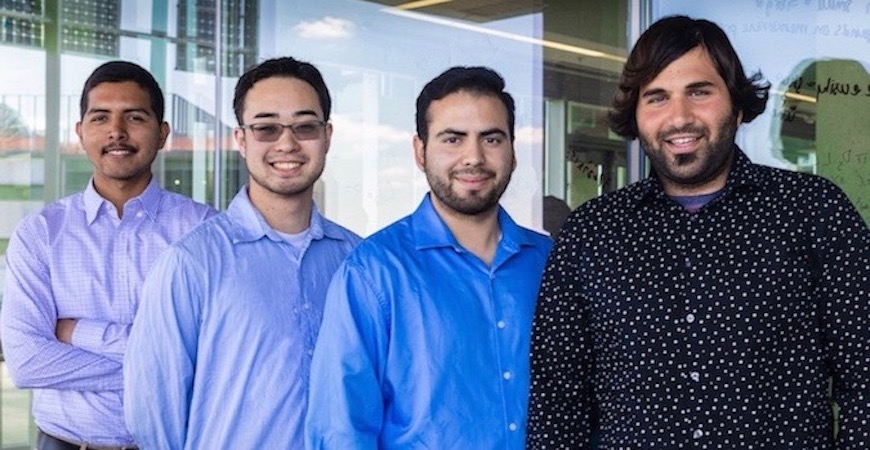
The undergraduate engineering curriculum at UC Merced offers students professional experience by participating in the senior capstone project, the Innovation Design Clinic (IDC). The IDC culminates in the Innovate to Grow event on Friday, May 17, from 7:30 a.m. to 5 p.m. in an annual showcase of student talent and ingenuity, highlighting the culture of entrepreneurship in UC Merced’s School of Engineering .
Prior to graduation, students collaborate with IDC Capstone industry partners, organizations such as NASA’s Jet Propulsion Laboratory (JPL) and Bay Area Rapid Transit (BART) to solve real-world, critical problems.
Rediscovering Starlite
Imagine an almost magical material with a thermal barrier so strong it can protect spacecraft from incineration during atmospheric re-entry.
UC Merced mechanical engineering seniors Christopher Toy, David Sagastume, Moataz Dahabra and Luis Soto are working with NASA’s Jet Propulsion Laboratory (JPL) on a methodology to rediscover the lost, secret formula for an intumescent material that resists extreme heat.
The material, originally named Starlite, was invented by Maurice Ward in the 1970s. Ward, from northern England, was an eccentric hairdresser and amateur chemist with no formal scientific training. In 1991, using mostly organic ingredients, such as cornstarch and baking soda, Ward famously demonstrated the material on television by holding a blowtorch on a Starlite-coated egg. After 10 minutes, the egg was merely warm to the touch and still runny inside.
Out of concern for the potentially malicious use of Starlite, and to protect his rights to patent, Ward died in 2011 without having brought the material to market — or ever revealing its formula to the public. Since then, researchers and inventors have been racing to replicate the legendary formula.
Now, a team of UC Merced seniors are working hands-on with Thomas Peev, an instruments engineer with JPL to develop a methodology to reinvent the material in a race to discover its properties and ingredients.
“We’re close; it’s feasible,” said Sagastume.
“We’re conducting a qualitative study to see what works,” said team member Toy. “Figuring out the right mixture is the main challenge; we may even help other inventors recover Starlite technology.”
“Most engineering programs include some form capstone design, but few have the strong focus on workforce readiness we have developed at UC Merced."

Working on the railroad
For their capstone project, UC Merced mechanical engineering seniors Alex Lopez, Chris Chalabi and Kapil Bulsara are collaborating with BART to develop a solution to the problem of extreme vibration in their fleet of maintenance vehicles.
“I really wanted to work with BART on this project,” said Bulsara. “I liked the dynamics, applying what I learned in vibrations class to a real-world problem and find a solution.”
A fleet of three, at a price of $3M each, the BART section cars can only withstand a minimum speed of 18 miles per hour until vibration occurs, becoming extreme at 30 mph. The cars need to cover about 30 miles during a given shift, at a minimum of 30 mph, which isn’t possible at their current rate of speed.
The UC Merced team is using sensors and accelerometers to measure vibration relative to gravity for a numerical calculation to determine the magnitude of the vibration — and the problem.
“Find the natural frequency of the vehicle, which will determine how the car oscillates,” said Lopez. “That’s the desired outcome.”
The team explained that by using a numerical method, they can develop a mathematical model that can be applied to any type of train vehicle, ultimately improving its efficiency and safety.
“The vehicle vibration team has identified, tested and procured the testing instrumentation needed to collect vehicle vibration data,” said Christian Reif, P.E., a senior engineer with BART.
These engineering challenges greatly benefit students who appreciate the opportunity to enhance their professional communications, collaboration skills and problem-solving capabilities, a direct result of working with industry partners in a real-world situation.
“We work closely with our partners to identify engineering design projects that are multidisciplinary, challenging, and feasible for our students,” said Alejandro Gutierrez, faculty advisor and professor in the School of Engineering. “By the end of class, these projects are implemented. Often, partners hire some or all the students they worked with to achieve a positive outcome.”
Lorena Anderson

Senior Writer and Public Information Representative
Office: (209) 228-4406
Mobile: (209) 201-6255






